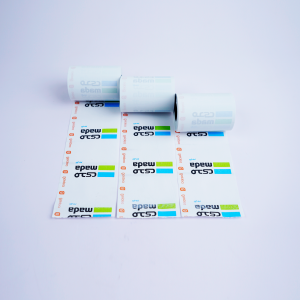Thermal paper is a commonly used paper type that is widely used in various industries and sectors. It is particularly popular in the retail, banking and healthcare industries for its ability to produce high-quality prints quickly and efficiently. Understanding how thermal paper printing can provide valuable insights into the technology behind it and its potential applications.
Thermal printing technology utilizes a special type of paper that is coated with a chemical called a thermal coating. The coating consists of colorless dyes and other heat-sensitive chemicals. It is this sensitivity to heat that allows paper to print without the need for ink or toner.
The thermal paper printing process involves the thermal print head, which is the main component responsible for heating the thermal coating. The printhead consists of small heating elements (also called pixels) arranged in a matrix pattern. Each pixel corresponds to a specific point on the printed image.
When electric current passes through heating elements, they generate heat. This heat activates a thermal coating on the paper, causing a reaction that produces a visible print. Thermal coating changes color due to heat, creating lines, dots, or text on the paper.
One of the main advantages of printing on thermal paper is its speed. Since no ink or toner is required, the printing process can be completed quickly. This makes thermal printing ideal for applications that require high-volume and fast printing, such as receipts, tickets, and labels.
Additionally, thermal paper printing provides excellent print quality. Thermal printers produce prints that are clear, precise, and resistant to fading. Thermal coating ensures long-lasting prints, ideal for documents that need to withstand harsh conditions, such as storage in hot or humid environments.
Thermal paper printing is also cost-effective. Without the need for ink or toner cartridges, businesses can save money on supplies. Additionally, thermal printers are relatively low-maintenance compared to traditional printers because there are no ink or toner cartridges to replace or clean.
There are many applications for thermal paper printing. In the retail industry, thermal paper is often used in receipts to ensure sales transactions are accurately recorded. In the banking industry, thermal paper is used to print ATM receipts and statements. In healthcare, it is used in tags, wristbands and patient information records.
However, it’s worth noting that thermal paper printing does have some limitations. It is only suitable for black and white printing, as the thermal coating cannot produce color printing. Additionally, thermal prints may fade over time if exposed to direct sunlight or high temperatures, so proper storage is crucial to maintaining their longevity.
To sum up, thermal paper printing is an efficient and economical printing technology. By utilizing a special thermal coating and the heat generated by the print head, thermal paper produces high-quality prints without the need for ink or toner. Its speed, durability, and clarity make it a popular choice across a variety of industries. However, it’s important to consider its limitations, such as the inability to produce color prints and the potential for fading over time. Overall, thermal paper printing remains a reliable and versatile option for businesses and individuals alike.
Post time: Nov-14-2023



